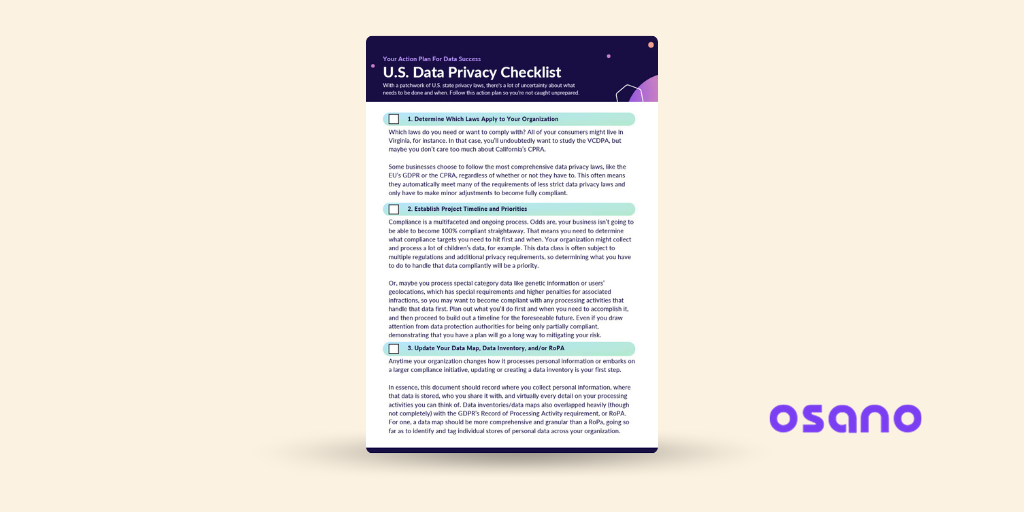Build a Business Case
There are plenty of reasons why your organization should want a privacy program. Among the reasons described above, there’s the desire to:
-
Be compliant with the law.
-
Avoid penalties and fines.
-
Build consumer trust.
-
Treat consumer data ethically.
-
And more.
Non-privacy experts may be able to see the value of these benefits, but they won’t have as much insight into the reality of data privacy compliance work. This is one of the key factors that leads to a privacy program that’s under-resourced, poorly scoped, and overwhelmed.
To really persuade and inform business stakeholders about the importance of a data privacy program, it’s essential that you build a business case.
A business case isn’t just a matter of extolling the benefits of a data privacy program; it’s about assessing costs and benefits, straightforwardly identifying challenges, considering how you’ll overcome them, prioritizing tasks, and making a plan.
Our blog, Making the Business Case for Your Data Privacy Program, dives into detail on how to approach this crucial task.
Know What Capabilities You Need
Naturally, you’ll make a more compelling case for your privacy program if you know what activities you intend to pursue. Even if your organization has complete buy-in to your privacy program from the jump, you’ll need to identify priorities and key capabilities in order to maximize your compliance outcomes.
This is easier said than done. Privacy professionals know they need a way to fulfill data subject access requests (DSARs), manage consents, conduct privacy assessments, and other regulatory requirements. What’s more difficult is knowing the specific actions you need to take to enable and operationalize those tasks while maintaining the efficiency of your privacy program as a whole.
In 16 Elements of a Data Privacy Program, we identify the full spectrum of privacy program elements that allow you to execute on regulatory requirements, administrative tasks, support tasks, and more.
Plan for Your Privacy Program’s Growth
Okay, you know how to gain support for your privacy program, you know what you want to do—what’s next?
Your organization’s data processing activities, structure, strategy, and goals aren’t going to stay the same; your regulatory environment is certain to change as new laws are created and old ones amended; your internal privacy strategy is going to evolve as well. How do you scale and mature your privacy program?
One way is to think about your privacy program in terms of maturity levels.
Download the infographic below to see an overview of a privacy program’s maturity levels.
-
Infographic: Osano Maturity Model
A Privacy Program Maturity Model
Building, scaling, and maintaining a data privacy program is a lot like data privacy itself: complex, multifaceted, and dynamic.
Putting all the guidance in this article together is no small feat. So, the team at Osano developed a resource that provides a step-by-step method to mature your privacy program’s operational efficiency over time.
The Osano Privacy Program Maturity Model gives you a framework to operationalize all of this. It:
-
Helps you identify your biggest needs.
-
Gives you an objective way to position privacy compliance in your organization.
-
Provides a means of measuring privacy program operational efficiency and build a case for resources and budgeting to leadership.
-
Gives you tangible ways to defend personal information and secure consumer trust.
Here’s how it works: the Maturity Model provides you with the tools to self-assess various elements of your data privacy program on a scale of 1 to 5, with 1 corresponding to less mature and 5 corresponding to more mature. For each element, the model suggests activities and steps you can take to increase your maturity.
Through this scoring exercise, you can identify priorities, plug gaps, and track growth over time. One excellent use of the Osano Privacy Program Maturity Model is as part of your quarterly, bi-annual, or annual review—you can measure and quantify your progress over time, helping demonstrate growth and return on investment to the rest of your organization.
Fill out the form to download the Osano Privacy Program Maturity Model and start your privacy program’s journey toward operational excellence.
.webp?width=1220&height=1090&name=Osano-guarantee-seal%20(1).webp)




